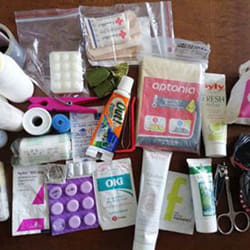It was my turn for the booster injection on November 5, one month after they started in Spain, and exactly six months since May 4, when I received my second dose. This time I got the injection at a local clinic, two minutes on foot, not like the previous two times which were at a large vaccination center set up in a general hospital. The last two times they took my temperature at the entrance, I disinfected my hands under the watchful eye of a staff member, and I had to wear a non-woven mask, the cloth mask I had made being no good. This time, they didn’t take my temperature, I could disinfect my hands if I wanted to, and cloth masks were OK. Judging by the article by Megumi Ota, Knowledge Network’s Portugal correspondent, things seem to have relaxed a lot in Spain.

Photo 1
Photo 1 shows I had no problem wearing my own cloth mask made from Japanese cotton hand towels (which has a reputation in the neighborhood). I say “cloth,” but I have been putting a sheet of paper towel in between the outer and the inner layers. At any rate, paper towels are made out of vegetable fibers called pulp and aren’t woven, so maybe it’s OK to call them non-woven paper.
Disposable non-woven masks, including masks for medical use, are made from polypropylene, polyester, and polyurethane, which come from petroleum oil, an astronomical number* of them have been thrown out as burnable garbage across the globe, and have been emitting CO2. In comparison, washable cotton masks fitted with paper are kinder to the environment, plus, they are also aligned with the SDGs, which everyone is talking about.
* Apparently 129 billion non-woven masks are used every month across the globe.
https://pubs.acs.org/doi/10.1021/acs.est.0c02178#
And this time I didn’t need a vaccination coupon, pre-examination report, or any appointment procedures at all. All I had to do was go to the designated location on the date and time notified by social media message and phone. The place I went to was too humble to be called a vaccination center. It was a makeshift arrangement, a reception area set up at the entrance to a clinic where they had brought in the necessary equipment. I went there at the designated time, there was no queue, and the medical office staff member and nurse were ready. They were the office worker who typed the data into the medical system terminal and the person taking care of the injections. There was the history taking first, but only one question: “¿Cómo estás?” (“How are you?”) That was it. The previous two times I was asked one more question: “¿Derecho o izquierdo?” (“Right or left?”). But not this time.
That was actually because I was getting the COVID-19 booster and the seasonal flu vaccine at the same time, so I had no choice but to get one injection in each shoulder. Of course, neither is compulsory and I had the choice to refuse either one or the other. In my case, I got to the room at the designated time, the injection was done in about three minutes, it took about one minute to print out the certificate, making a total of just under five minutes. It was all over at the clinic in about 20 minutes, which included the 15 minutes after the vaccination, waiting inside under observation, as agreed. Incidentally, not only were the COVID-19 and flu vaccinations free, so too were the pneumococcus, tetanus, diphtheria, and other vaccinations.

Photo 2
Photo 2 shows the information about the third COVID-19 vaccine injection at the clinic. There is no record here of the flu vaccine injection.

Photo 3
Photo 3 shows the EU certificate of registration of my third booster vaccine dose, which I downloaded using the Tarjeta Sanitaria Virtual de Madrid (Madrid Virtual Health Card) app. This only shows the date of my last vaccine injection (the third one), not the dates of the previous two. Plus, the only manufacturer’s name it shows is BioNTech, not Pfizer. I wonder if it’s the EU's intention to highlight the fact that it’s made in Europe.

Photo 4
Photo 4 shows the history of my other vaccinations going back 10 years, which I downloaded via the app.
I am an elderly man and have an underlying medical condition, so as far as any side effects go after my double injection, I felt a dull ache in both shoulders (the front of my deltoid muscles) for about two days, but luckily, two weeks later, I still have not had any subjective symptoms from the double vaccination. By the way, the three vaccine doses were all Pfizer/BioNTech.
The northern hemisphere has reached the time of the year when the authorities get concerned about the spread of seasonal flu. Last winter, a lot of people acted out of anxiety about COVID-19, but most people didn’t actually regard it as a problem after all, so now COVID has settled down compared to back then, and people have dropped their guard, so that may be why this year there is more concern than ever before about the spread of the flu. Maybe it’s because people see the possibility of a "twin-demic," where you get a flu pandemic alongside the COVID-19 pandemic, that since October when flu vaccinations started up again, people have been getting double vaccinations, the flu vaccine together with their COVID-19 booster vaccine. This kind of double mixed vaccination already started in the UK and other countries in September.
Flu vaccinations started in Japan too, in October, and COVID-19 booster vaccinations will start in December, including cross vaccination using the Comirnaty vaccine manufactured by Pfizer/BioNTech, which received special approval on November 11. But in the opinion of the Ministry of Health, Labour and Welfare, “In principle, a COVID-19 vaccine cannot be given at the same time as another vaccine. Either the COVID-19 vaccine or the other vaccine can be given two weeks after receiving the other...”
https://www.cov19-vaccine.mhlw.go.jp/qa/0037.html
Across the world the trend has been different. In anticipation of the imminent winter flu season, various organizations have flagged that vaccines may be mixed and can be given at any time, even simultaneously, including the World Health Organization (WHO, on October 21), the US Centers for Disease Control and Prevention (CDC, on August 31), the UK Public Health England (PHE, on August 6), the German Standing Committee on Vaccination (STIKO, on September 14), the French National Authority for Health (HAS, on August 23), and the Israeli Ministry of Health (IMH, on June 24). Some countries, like France, have even ventured to encourage simultaneous vaccination, and as I mentioned, simultaneous vaccination is the default in Spain. I guess there are two intentions here, to avoid the risk of contracting one or the other during the two-week waiting period, and also to lighten the workload of the medical institutions by getting two injections done in one go. It also helps to save time and effort for people who are not very mobile, or who have to go a long way to a vaccination clinic.
Prime Minister Kishida said in his first speech after inauguration of the new cabinet, “I intend to bring a sense of urgency to a raft of issues.” In view of emphasis by the Health Sciences Council (the subcommittee on immunization and vaccination) in the Ministry of Health, Labour and Welfare on the "status of responses being implemented by other countries,” this might be an opportunity to take another look with “a sense of urgency” at the prohibition of simultaneous COVID-19 and flu vaccinations, as a measure against a “twin-demic,” the spread of COVID-19 and influenza, which is a pressing issue as winter approaches in Japan.
I hope you understand that while these articles are for sharing information about Spain, they are also a place where I express my concerns about my homeland far away.




























































